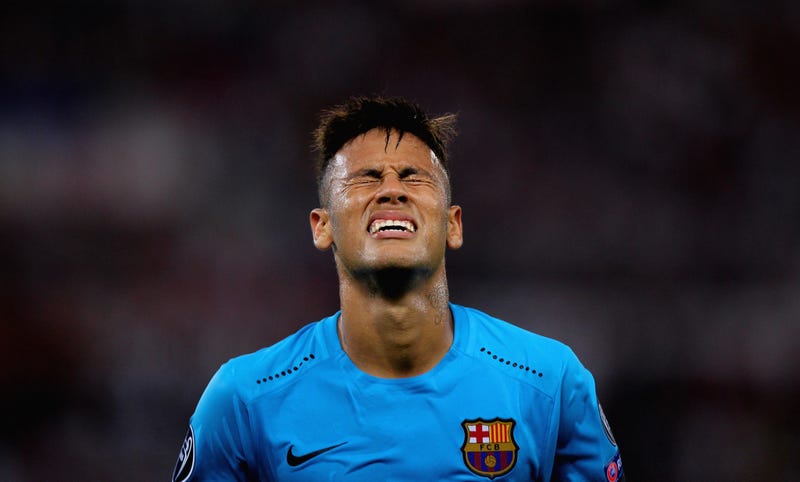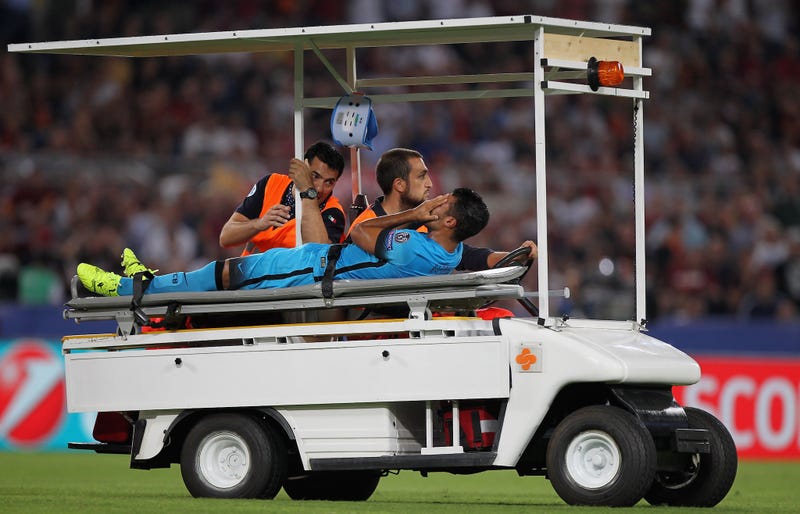
Barcelona’s
dominant victory over Atlético Madrid this weekend felt like a
statement. It’d be crazy to claim that the reigning Spanish and European
champions, armed with nearly the exact same squad that mowed down all
comers in last season’s historically great campaign,
were underestimated or overlooked in any significant way. But coming
into this season, you couldn’t help but look at the club’s limited,
largely unproven bench and see the potential for calamity should the
Injury Gods inflict their wrath.
That’s was
what made Saturday’s win so impressive. It wasn’t just how they managed
to dictate the terms of play against a team that only a couple seasons
ago appeared to have solved the riddle
of Barça’s system. Nor was it how, through quick decision making and
darting runs, they turned what is typically Atléti’s marble-solid back
line into pumice, sifting through it seemingly at will.
No, what
stood out most was the personnel with which they accomplished all of
this. Dani Alves, Gerard Piqué, and Lionel Messi were all missing from
the starting lineup that day. In their place were hardly what you’d
consider world-beaters: for Alves, Sergio Roberto, a natural box-to-box
midfielder who never made an impact at his real position before the
surprising decision this summer to switch him to right full back as a
stopgap cover for Alves; for Piqué, Thomas Vermaelen, an accomplished
though perma-injured center back that had made exactly one appearance
for the club the season prior; and for Messi, Rafinha, a promising,
young Swiss army knife of a midfielder.
All three
players excelled in Madrid, as they had all season in the important
roles into which they’d been thrust thanks to injuries, suspensions, and
happier absences (welcome to the world, Mateo Messi!).
Roberto took to the full back position automatically, able to use his
athleticism, work-rate, and intelligence in understanding when to push
forward and when to drop back in a way his limited technical ability
didn’t allow for when he played in the center of the pitch. Vermaelen
had been Barcelona’s best defender in most of his appearances, making a
strong case that he should be the team’s third center back behind Piqué
and Javier Mascherano. (Surprise, surprise: he had to be substituted
early in the Atlético match due to injury.)
But the
most promising turn of events was the growth of Rafinha. He’s long been
considered one of the jewels of Barça’s youth quarry. Rafinha, the
22-year-old brother of Barcelona youth product and current Bayern Munich
player Thiago, is some kind of player:
The
attack-minded midfielder’s most lethal weapon is his dribbling; he can
speed and spin past any number of defenders. But what makes him so
promising are the other things that go along with his game: the creative
passing, the movement, the willingness to defend, the goal-scoring
ability. These are all attributes Rafinha has flashed at times in his
career and this season has finally put together for more sustained
stretches. No one who pays close attention to this club would be at all
surprised if a couple years down the line he became a more-than-capable
replacement for Andrés Iniesta.
So
Barcelona beat Atlético away from home 2-1, and everything looked great.
Maybe they could sustain this another few months, cobbling together
shorthanded results until their transfer ban is lifted and
reinforcements can arrive. Then the Roma match came and Rafinha got hurt
and now Barça are in a whole hell of a lot of trouble.
Away to
Roma on Wednesday for what would most likely be their most difficult
match in the Champions League group stage, Barcelona were at nearly full
strength with Piqué and Messi back in the side. Again the team looked
ascendent and very easily could’ve won barring one of the most stunning long bombs
you’ll ever see. In the second half, though, manager Luis Enrique
brought on Rafinha for Ivan Rakitić. Just a couple minutes later, the
young Brazilian was being carted off the pitch after an ugly Radja
Nainggolan tackle. (We’ve heard that one before.) Scans revealed that Rafinha suffered a torn ACL and will be out at least six months. Sometimes all you can do is sigh.

Rafinha was
by himself a huge chunk of Barça’s depth. Not only was he the fourth
central midfield option, spelling Rakitić or Iniesta when they need
breathers, but he was also the first-choice sub for the three forwards.
Earlier this season he played on the left in place of a mumpy Neymar,
and just this weekend he stepped in on the right for Messi, both of
which have augmented the minutes he’s spent in his long-term position in
central midfield.
Without
him, Barcelona will struggle to make it through to January in one piece.
Before the end of the calendar year, the club has 18 scheduled La Liga
and Champions League matches, plus a handful more in the FIFA Club World
Cup. They’ll go into those matches with only four central midfielders
currently in the side (Sergio Busquets, Rakitić, Iniesta, and
Roberto—five if you count Mascherano). Even more distressing is the
quality behind the forwards. The Messi-Suárez-Neymar
trident is the core of this team, and now they’ll have to pray those
three stay healthy and in form, or else they’ll have to turn to a pair
of super raw and frankly unprepared 20-year-olds in Sandro Ramírez and
Munir El Haddadi. A bench as shallow as a kiddie pool sprang a leak when
Rafinha went down.
Luckily,
none of the front seven ahead of the defense in Barça’s preferred XI are
particularly injury prone. An ideal world would see those players slog
through without too much wear and tear. With fatigue sure to be an
issue, the club will probably play Mascherano more often in midfield and
less in defense for rotation’s sake. Barcelona have never looked
particularly good the handful of times Luis Enrique has tried playing
Mascherano and Busquets together, but desperate times and all that.
Outside of
shifting the vets’ minutes around more creatively, the youth will have
to step up. Munir became one of the hottest young names in the game
thanks to his call-ups with Barça’s first team early on last season, and
he and Sandro—who’s actually been the more effective player of the two
young strikers when given the opportunity—will be thrown into the deep
end to see if they can swim.
In
midfield, the most likely candidate to fill in for Rafinha would
presumably be Sergi Samper. Samper has been called everything from the
next Busquets to the next Xavi since he was a teen, but it doesn’t seem
like Luis Enrique trusts him to approximate either of those player’s
talents any time soon, judging from his lack of minutes in the preseason
and the call-ups fellow Barça B midfielder Gerard Gumbau has gotten at
his expense. Still, Samper has experience with Barça proper and has the
pedigree to do something great.
Bringing
along and trusting youth products has been a part of Barcelona’s very
DNA, but usually those minutes were earned by superior talents rather
than gifted out of necessity. It’s sort of ironic, actually; one of the
key topics of interest in this past summer’s club presidential elections
was the perceived decline of the Barcelona youth system. Josep Maria
Bartomeu, the former VP and ultimate victor, was painted as the
embodiment of the system’s impending demise, more comfortable buying
established players from elsewhere than focusing on improving the
in-house ranks. His challengers promised to restore the Johan Cruyff model of homegrown development that has stocked the club during the remarkable run of this past decade.
In the end Bartomeu won, and because of transfer sanctions
(in which he played a major part in incurring) his first full season as
elected president could very likely rest on the youth. By the time
January comes around and the option for further investment is open
again, we’ll have a good idea whether the youngsters were worth trusting
just yet.

No comments:
Post a Comment